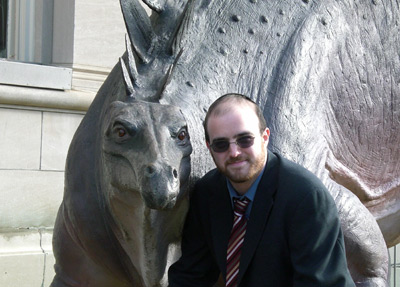Zombie Rav
The New York Times's blog thinks this is interesting.
It reminds me of a discussion I had once with Lakewood Yid about the late last Lubavitcher Rebbe.
Zombie Apocalypse on a Synagogue Wall
I think it's redundant to say that no, a zombie apocalypse is not what we pray for in the second berakha of the ‘Amida when we proclaim God to be מחייה המתים, the One who Returns the dead to Life.
Feel free to hypothesize about the halakhic status of reanimated corpses (encephalophagy optional) in the comments...
It reminds me of a discussion I had once with Lakewood Yid about the late last Lubavitcher Rebbe.
I think it's redundant to say that no, a zombie apocalypse is not what we pray for in the second berakha of the ‘Amida when we proclaim God to be מחייה המתים, the One who Returns the dead to Life.
Feel free to hypothesize about the halakhic status of reanimated corpses (encephalophagy optional) in the comments...



6 Comments:
So the big question is whether reanimated corpses are required to keep kosher? Or does one lose one's affiliation upon becoming the walking dead.
The second question is if a zombie needs to worry about Creutzfeld-Jacob disease?
Siz a shverre zach. Oder aigentlik, es zainen tzvai schverre zachn. Oder nain, drai shverre zachn. Yo, drai.
Zolst diskussiern, zeit azoy git.
That link brought me to a post about the DOT's rules for eruvin, which ends like this:
"In June, City Room noted the expansion of an eruv in Manhattan, to include parts of Midtown and Greenwich Village, and neighborhoods like Murray Hill and Gramercy Park.
Those neighborhoods do not have high concentrations of observant Jews. Neither is Sunnyside heavily Jewish. But Betty-Ann Weiner, a synagogue board member, and a painter who has lived in Sunnyside for about 30 years, said the eruv has been greeted in the community with a collective shrug – perhaps a result of the famous seen-it-all diversity of the neighborhoods in Queens along the No. 7 train.
“Do you know, there’s so many people with so many garbs walking around here, so many people with this kind of thing on their head, that kind of thing,” said Ms. Weiner, who wore a purple scarf on hers. “People just say, ‘Oh, OK.’” "
New York City is a beautiful place.
Er veist, naturlech, az Moish Rabbeinu a Satmar chossid iz? Einfech. Es shtait in Chumesh az der mishkan war tzein amois (60 tfachem) hoch, Moishe Rabbeinu war oych tzein amois (60 tfachem)..... which means he could ONLY have worn a shtraimel (aigentlik a plutshikke biber-pelts, nisht an emmese fuks-peltste kitshmeh vi heint geveintlich iz), rather than a kulpak, or a spodek. Kler, nu?
So, Moishe could only be a Satmar chossid because it is a MAIN Satmarer minneg (minhag) to wear a flat hat, ober only a minor Bresloiver minneg (minhag), siz not so common - if he had been a Bresloiver, flat hats would be now main Bresloiv minneg (instead of the daivuhzity we see today), ergo, mamish, he could only have been Satmar.
So, vatch the Satmar channel in good health.
Unless, of course, he was crouching. Chos ve sholom.
When I first read the title of the post, I thought of the espisode of The Simpsons where Ned goes around looking for brains. But in regards to halakha and zombies, what other problems would they encounter beyond kosher? Or would their status as a non-human mean that halakha doesn't apply to them at all?
Not a shtreimel, says the video, but a "plotche biber" - the flat beaver hat.
Post a Comment
<< Home